A Los Pectorales... La Posición de las Manos en las Flexiones, Sí Importa [Esp/Eng]
Como es sabido, las flexiones, independientemente de sus variantes, están orientadas al desarrollo y fortalecimiento de la musculatura del tren superior, activando en cierta forma el abdomen y el tren inferior, ya que también coadyuvan en la dinámica articular, y el mantenimiento de la postura corporal. Estos movimientos mejoran la resistencia y fuerza en nuestro cuerpo; no requieren de ningún tipo de aparato durante su ejecución, siendo llevadas a cabo en cualquier lugar, no importa el sitio, solo llevas el cuerpo al suelo e iniciamos con la acción, claro está siguiendo las indicaciones. En nuestro caso, aunque sabemos que toda la musculatura superior interviene en los movimientos para obtener beneficios, nosotros vamos al desarrollo de los pectorales en toda su extensión.
Normalmente pensamos que al realizar las flexiones, solo nos vamos al suelo sin importar donde se ubican las manos, y comenzamos a movernos creyendo que estamos trabajando los músculos deseados. Pero esto no es así, porque la actividad muscular varía de acuerdo a como coloquemos las manos, y si vamos a darle acción a las zona de los pectorales, la posición de las mismas sí importa porque dependiendo de esto, podemos desarrollar la región pectoral superior, media, e inferior. Así que mis amigos vamos todos a darle acción al cuerpo, sabemos que se habla mucho de las flexiones, pero ahora te hablo de como hacerlo para que tengas pechos de acero y bien formados, quédate con tu entrenador favorito. Vamos.
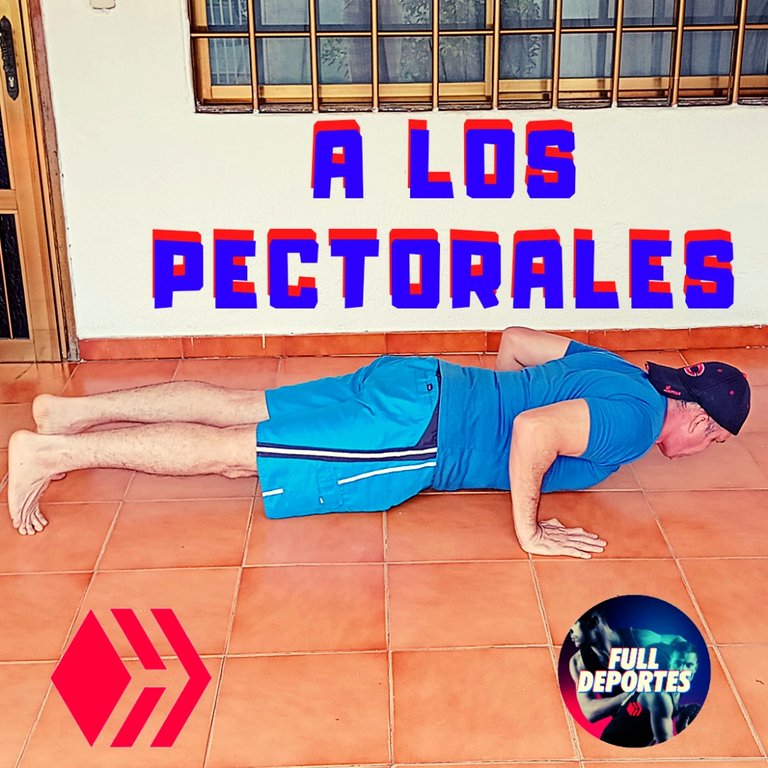
Imagen de mi Autoría Editada por/Image of my Authorship Edited by Canva
As is known, push-ups, regardless of their variants, are oriented to the development and strengthening of the upper body muscles, activating in a certain way the abdomen and lower body, as they also contribute to joint dynamics and the maintenance of body posture. These movements improve the resistance and strength in our body; they do not require any type of apparatus during their execution, being carried out anywhere, no matter the place, just take the body to the floor and start with the action, of course following the indications. In our case, although we know that all the upper musculature is involved in the movements to obtain benefits, we go to the development of the pectorals in all its extension.
Normally we think that when performing push-ups, we just go to the floor regardless of where the hands are placed, and we start moving believing that we are working the desired muscles. But this is not so, because the muscle activity varies according to how we place the hands, and if we are going to give action to the pectoral area, the position of the hands does matter because depending on this, we can develop the upper, middle, and lower pectoral region. So my friends let's all give action to the body, we know that there is a lot of talk about push-ups, but now I'm going to talk about how to do it so you have breasts of steel and well formed, stay with your favorite trainer. Let's go.

Estructura de la #Rutina
Calentamiento Corporal
- Nadador con flexión de rodillas.
- Apertura de brazos en T y Y.
#Rutina Activa
- Flexiones diagonales en salto con apoyo de rodillas.
- Trabajo de la zona superior de los pectorales.
- Trabajo de la zona media de pectorales.
- Trabajo de la zona inferior de los pectorales.
Relajación Corporal
- Flexiones cobra.
- Knee bending swimmer.
- T and Y arm openers.
- Diagonal push-ups in jumping with knee support.
- Work of the upper area of the pectorals.
- Work of the middle area of the pectorals.
- Work of the lower zone of the pectorals.
- Cobra push-ups.

Dinámica de la #Rutina
- Calentar antes de entrenar
- Dinámica: En circuito
- Trabajo por ejercicio: entre 10 Y 20 (se indica) repeticiones.
- Series: 4 por circuito completo.
- Descanso entre ejercicios: de 10 a 20 segundos.
- Descanso entre series: de 1 a 2 minutos.
- Warm up before training
- Dynamics: In circuit
- Work per exercise: between 10 and 20 (indicated) repetitions.
- Series: 4 per complete circuit.
- Rest between exercises: 10 to 20 seconds.
- Rest between series: 1 to 2 minutes.

Calentamiento Corporal
Iniciamos la acción de esta rutina con los ejercicios de calentamiento. Movimientos que son sumamente importantes y obligatorios, para que nuestro cuerpo en general se ponga a tono para la acción fuerte. Con los calentamientos buscamos que la temperatura corporal se eleve, así como también el ritmo cardíaco; al inicio los músculos están rígidos, por lo que para evitar lesiones esta fase no debe dejarse de lado. Así que amigos míos, a calentar se ha dicho.
We start the action of this routine with warm-up exercises. Movements that are extremely important and mandatory, so that our body in general gets in tune for the strong action. With the warm-ups we seek that the body temperature rises, as well as the heart rate; at the beginning the muscles are stiff, so to avoid injuries this phase should not be left aside. So my friends, let's warm up.

Nadador con flexión de rodillas
La fase de calentamiento comienza con este ejercicio. Para ello nos colocamos de pié con los brazos extendidos al frente. Las rodillas un poquito flexionadas. Una vez en posición, comenzamos el giro de brazos hacia atrás y adelante, y al mismo tiempo le damos flexión y extensión a las rodillas. Realizamos el ejercicio por 3 minutos continuos.
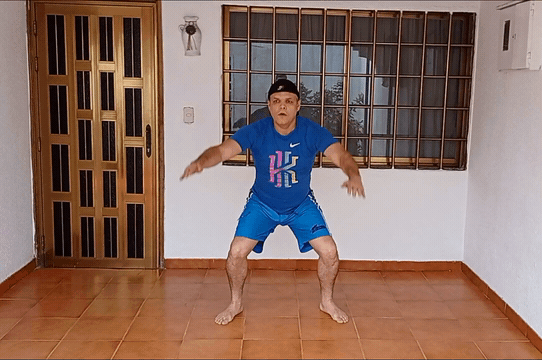
Knee bending swimmerThe warm-up phase begins with this exercise. To do this, we stand upright with our arms extended in front of us. Knees slightly bent. Once in position, we begin the arm swing back and forth, and at the same time we give flexion and extension to the knees. We perform the exercise for 3 continuous minutes.

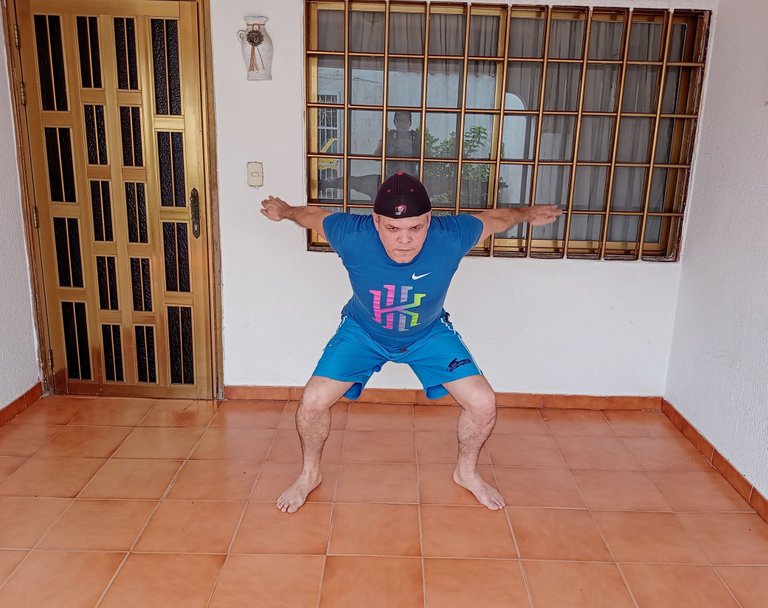
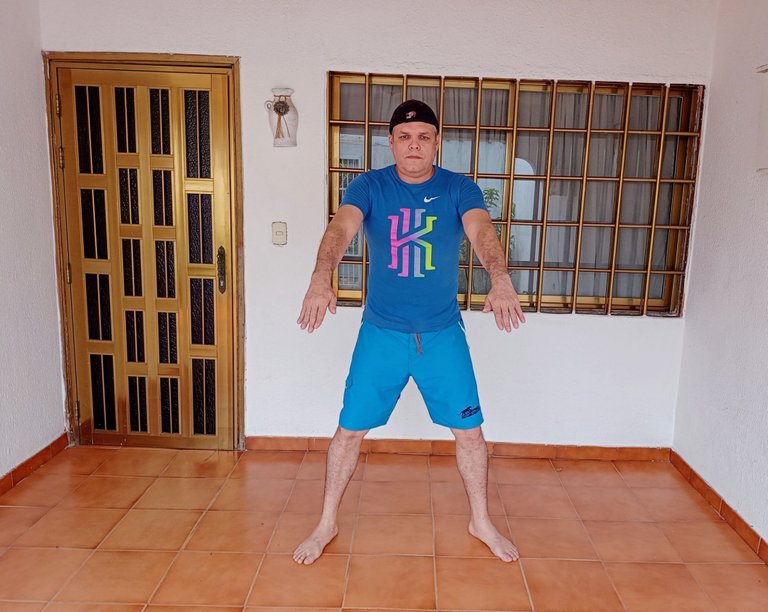

Apertura de brazos en T y Y
Nuevamente de pié, extendemos los brazos al frente y abajo. Acto seguido, subimos y abrimos los brazos a los lados quedando como una T. Llevamos los brazos a la posición inicial, para luego abrirlos otra vez hacia arriba, pero en esta oportunidad formando una Y. Nos vamos con este ejercicio por 3 minutos más.
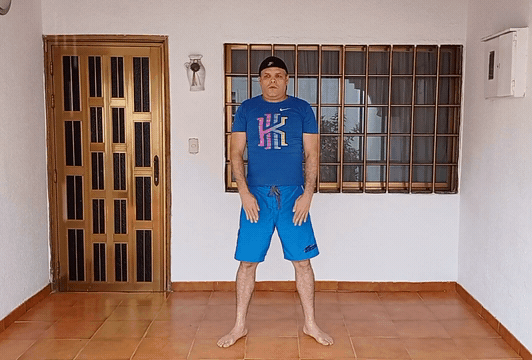
T-arm and Y-arm extensionAgain standing, we extend our arms in front and down. Next, we raise and open our arms to the sides in a T-shape. We bring our arms back to the starting position, and then open them up again, but this time forming a Y shape. We leave with this exercise for 3 more minutes.
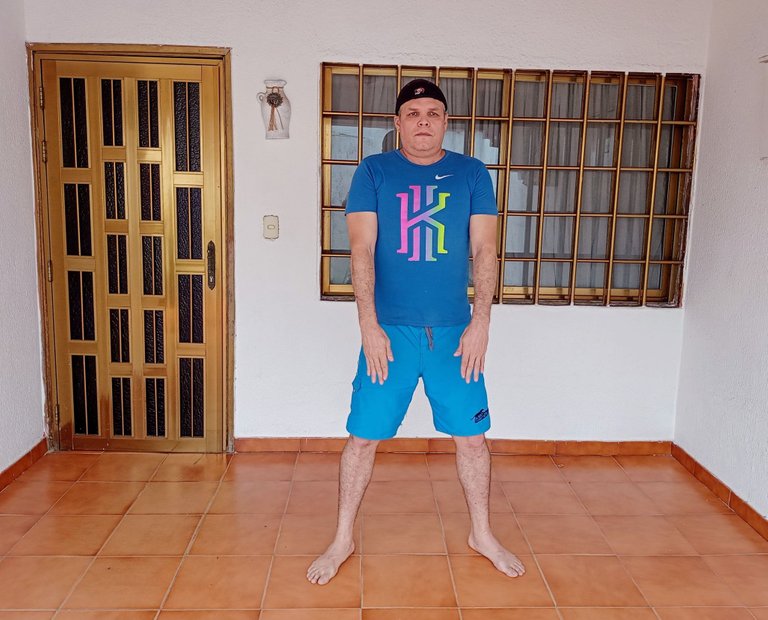
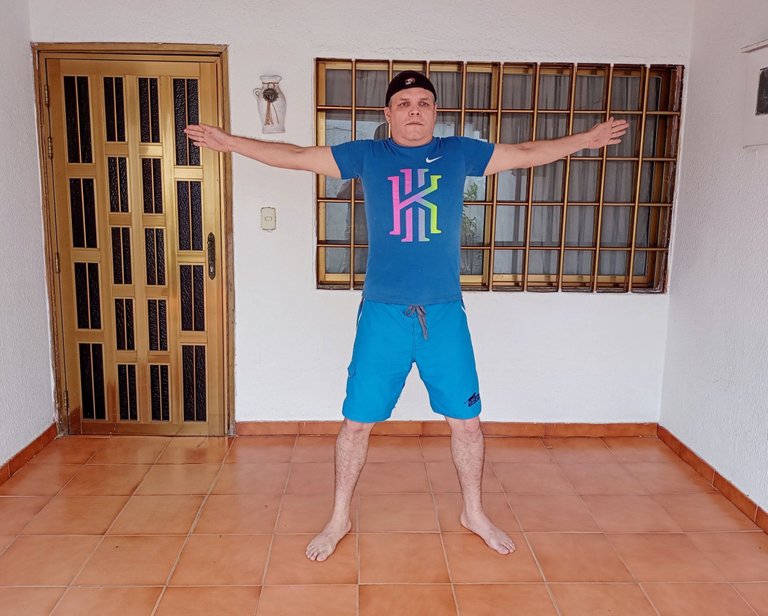

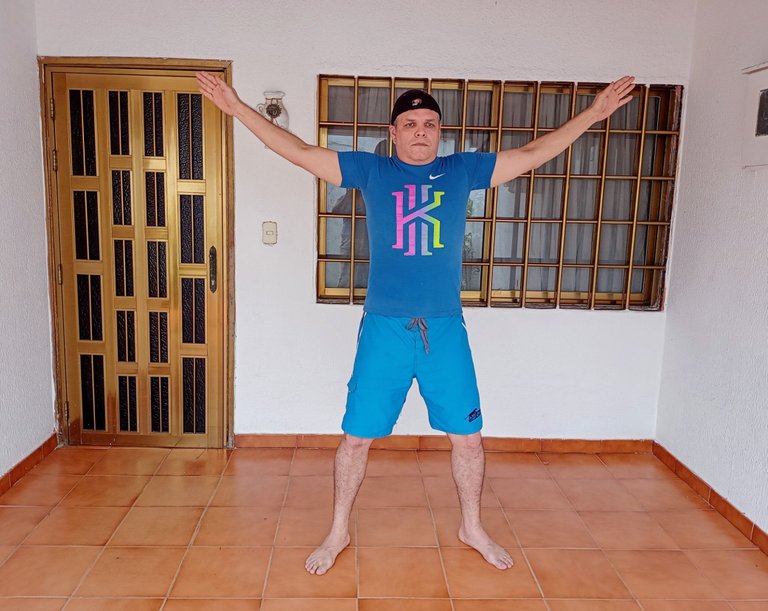

#Rutina Activa
Avanzamos, solo si el cuerpo ha cumplido las exigencias de los calentamientos. Recordemos que el cuerpo debe estar caliente, los músculos flexibles, y el ritmo cardíaco elevado; de no ser así, calentemos un poco más. No debemos olvidar mantener el abdomen y glúteos contraídos. Vamos a la acción.
We move forward, only if the body has met the demands of the warm-ups. Remember that the body must be warm, the muscles flexible, and the heart rate elevated; if not, warm up a little more. We must not forget to keep the abdomen and buttocks contracted. Let's get into action.

Flexiones diagonales en salto con apoyo de rodillas
Aunque ya hemos realizado los calentamientos, este ejercicio lo coloco en el circuito para darle un poco más de acción al tren superior, antes llevar a cabo los ejercicios más complicados. De igual manera, el presente ejercicio puede ser usado por aquellos hermanos principiantes, o que no tienen la suficiente fuerza para realizar las flexiones de forma normal.
Ahora, con el apoyo de dos cojines para proteger las rodillas, los colocamos, uno debajo de cada rodilla, lógicamente éstas deben estar flexionadas y los pies apoyados de la pared. Colocamos el torso de forma diagonal y las manos en el piso, con separación un poco más allá del ancho de hombros. Ya en la posición deseada, elevamos el torso despegando las manos del piso, y lo giramos para que quede de forma diagonal en el otro extremo, caemos ejecutando la flexión. Con el impulso, volvemos a subir para dirigirnos al punto de inicio, caemos nuevamente para realizar la flexión de codos. Nos mantenemos con estos movimientos por 20 repeticiones en 4 series.
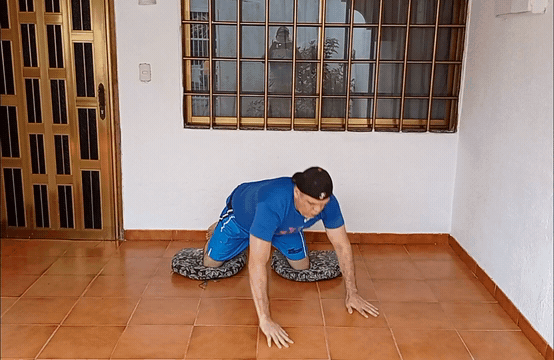
Diagonal push-ups in jumping with knee supportAlthough we have already done the warm-ups, I place this exercise in the circuit to give a little more action to the upper body, before carrying out the more complicated exercises. Likewise, this exercise can be used by those brothers who are beginners, or who do not have enough strength to perform the push-ups in a normal way.
Now, with the support of two cushions to protect the knees, we place them, one under each knee, logically these must be bent and the feet resting on the wall. We place the torso diagonally and hands on the floor, with separation a little beyond the width of shoulders. Once in the desired position, we raise the torso lifting the hands off the floor, and we turn it so that it is diagonally at the other end, we fall executing the flexion. With the momentum, we go up again to go to the starting point, we fall again to perform the elbow flexion. We keep these movements for 20 repetitions in 4 sets.
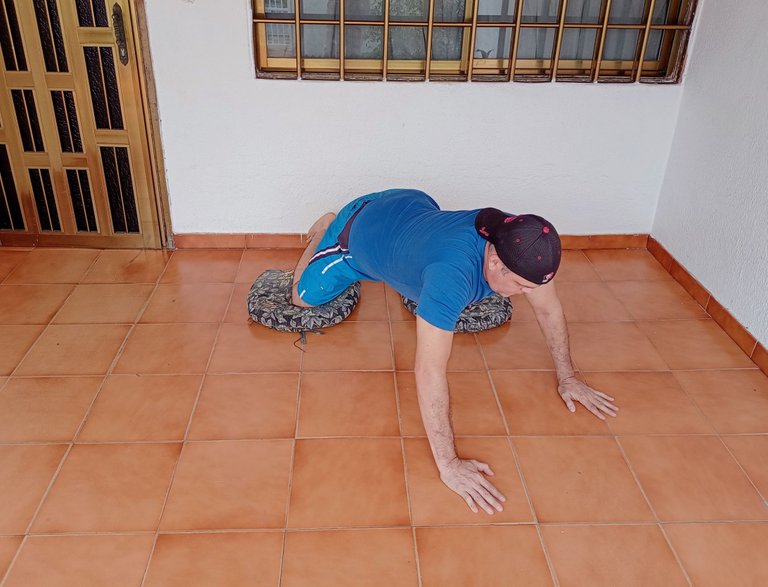
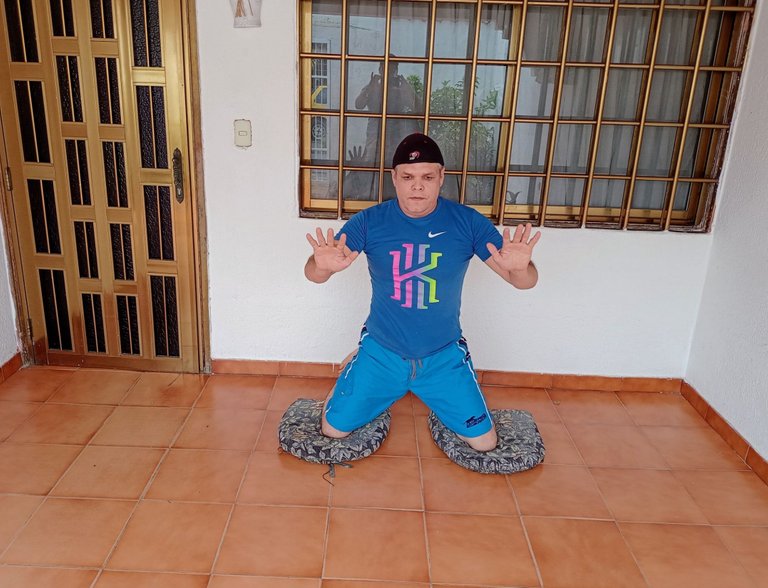


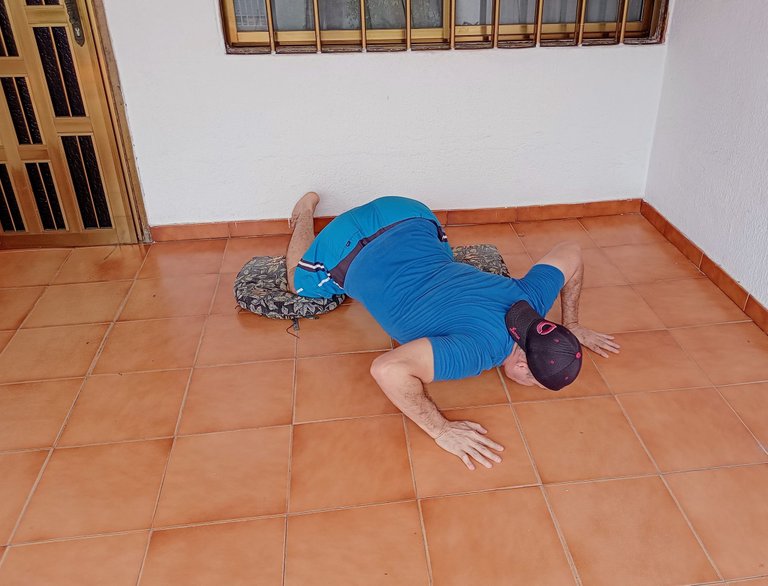

Trabajo de la zona superior de los pectorales
Con este ejercicio vamos al desarrollo de la parte superior del pecho o pectorales, además también tienen beneficios el resto de los músculos del tren superior. Nos colocamos en posición de flexiones, con piernas abiertas al ancho de hombros, y brazos separados más allá del ancho de los mismos, ubicando las manos a nivel de la frente del rostro.
Una vez en posición, flexionamos los codos, el cuerpo debe inclinarse un poco hacia adelante quedando los pies prácticamente de puntillas. Al bajar el cuerpo, nos daremos cuenta que las manos quedan a nivel de la parte superior de los pectorales. Con este movimiento de subida, inclinación, y bajada le damos desarrollo a la parte alta del pecho. No olvidemos que el abdomen y tren superior sirven de apoyo. Realizamos 15 repeticiones en 4 series.
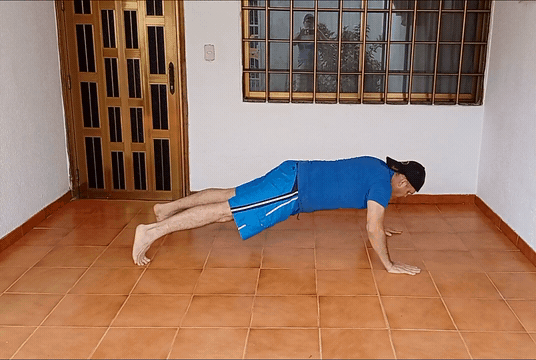
Work of the upper area of the pectoralsWith this exercise we go to the development of the upper chest or pectorals, in addition also have benefits the rest of the muscles of the upper body. We place ourselves in a push-up position, with legs shoulder-width apart, and arms separated beyond the width of the same, placing the hands at the level of the forehead of the face.
Once in position, we bend our elbows, the body should lean forward a little, keeping our feet practically on tiptoe. When lowering the body, we will notice that the hands are at the level of the upper part of the pectorals. With this movement of ascent, inclination and descent, we develop the upper part of the chest. Do not forget that the abdomen and upper body serve as support. We perform 15 repetitions in 4 series.

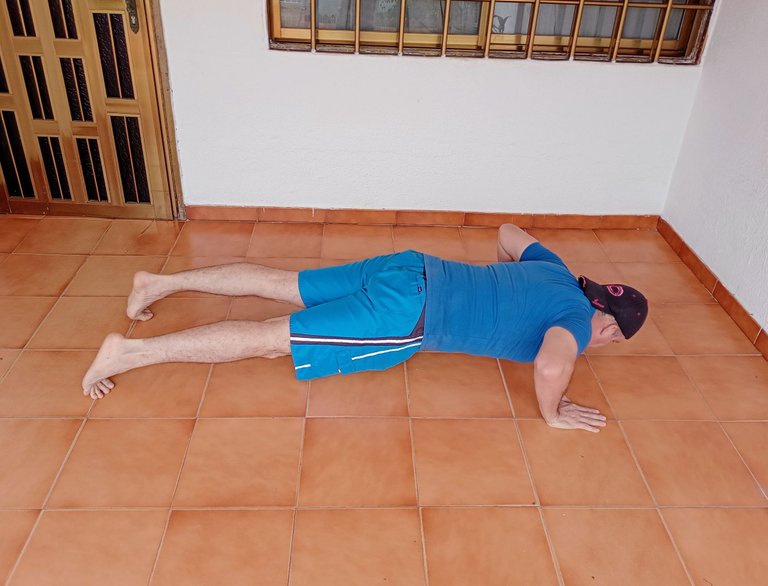

Trabajo de la zona media de los pectorales
De igual manera, aquí vamos a trabajar todo el tren superior, con énfasis en la parte media de los pectorales. Aquí tampoco dejamos de lado el abdomen y tren inferior, ya que debemos tenerlos contraídos en todo momento. Nuevamente, adoptando la posición de flexiones, con piernas separadas al ancho de hombros, y brazos abiertos más allá del ancho de los mismos, colocamos las manos, esta vez entre la barbilla y la zona superior del pecho.
Ya en la posición deseada, flexionamos los codos, inclinas el cuerpo hacia adelante, y los pies quedan en puntillas; verás que al bajar el cuerpo las manos llegan a nivel de la región media del pecho. Vuelves a subir y repites el procedimiento. El objetivo, el esperado, acción directa en la parte media pectoral. Realizamos 15 flexiones en 4 series.
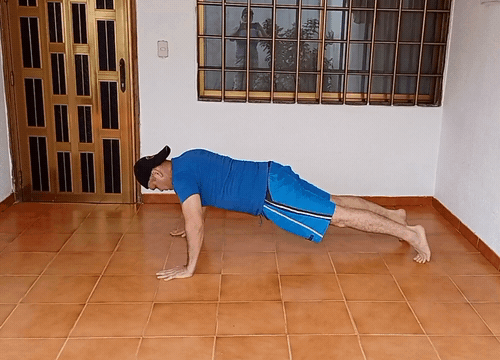
Work of the middle area of the pectoralsSimilarly, here we are going to work the entire upper body, with emphasis on the middle part of the pectorals. Here we also don't leave out the abdomen and lower body, as we must keep them contracted at all times. Again, adopting the push-up position, with legs shoulder width apart, and arms open beyond shoulder width, we place our hands, this time between the chin and the upper chest area.
Once in the desired position, bend your elbows, lean your body forward, and your feet remain on tiptoe; you will see that when you lower your body your hands reach the level of the middle region of your chest. You go back up and repeat the procedure. The goal, as expected, direct action in the middle part of the pectoral. We perform 15 push-ups in 4 sets.

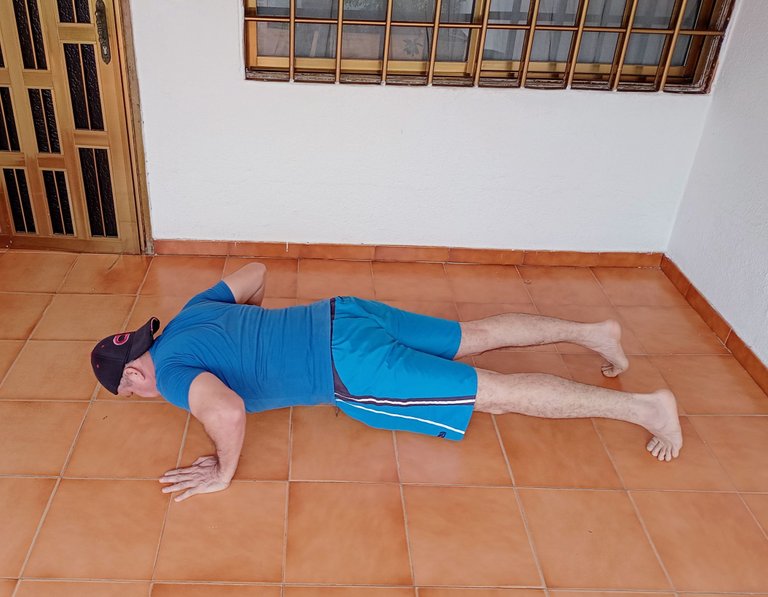

Trabajo de la zona inferior de los pectorales
Este ejercicio, por la posición final en que quedan las manos, es un poco más complicado. Igualmente desarrollamos la zona inferior del pecho, pero los brazos y hombros sienten tensión de locura. El abdomen y glúteos debemos tenerlos bien contraídos, para obtener resultados fascinantes.
Nos colocamos en posición de flexiones al igual que los dos ejercicios anteriores; la diferencia, es que ahora las manos se ubican a nivel de la parte superior del pecho. Nos vamos a la acción flexionando los codos, igualmente inclinamos el cuerpo hacia adelante, los pies quedan en puntillas, observando que al realizar la flexión las manos llegan a la zona inferior del pecho, casi en el centro del torso. Subimos, para luego realizar 15 repeticiones en 4 series.
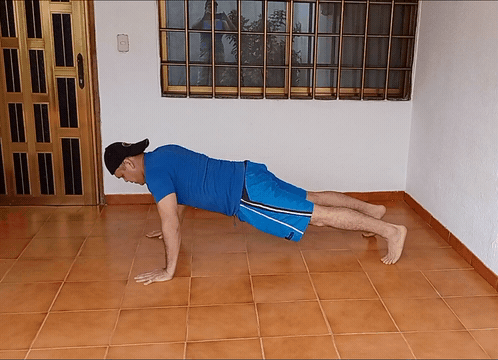
Work of the lower zone of the pectoralsThis exercise, because of the final position of the hands, is a bit more complicated. We also develop the lower chest area, but the arms and shoulders feel crazy tension. The abdomen and buttocks must be well contracted, to obtain fascinating results.
We place ourselves in a push-up position just like the two previous exercises; the difference is that now the hands are placed at the level of the upper chest. We go to the action bending our elbows, we also lean the body forward, the feet are on tiptoe, noting that when performing the flexion hands reach the lower chest area, almost in the center of the torso. We go up, and then perform 15 repetitions in 4 sets.
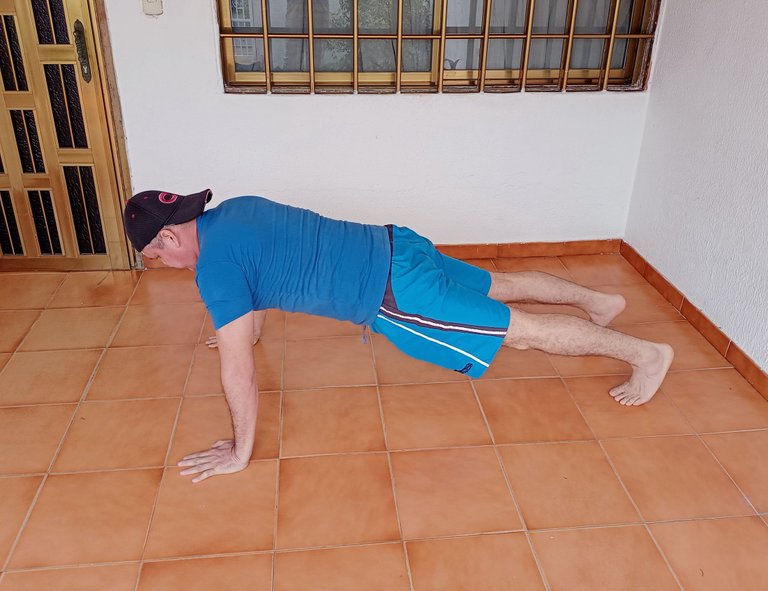


Relajación Corporal
Vamos ahora con el ejercicio de relajación, para llevar el cuerpo a su estado inicial. Siempre ejecutando las respiraciones de rigor.
Let's go now with the relaxation exercise, to bring the body to its initial state. Always executing the rigorous breathing.

Flexiones cobra
Nos acostamos boca abajo con los codos flexionados, y las manos ubicadas a los lados de los hombros. Piernas juntas. Ahora respiramos, extendemos los codos, y subimos el torso, exhalamos, bajamos, y repetimos el ejercicio por 3 minutos.
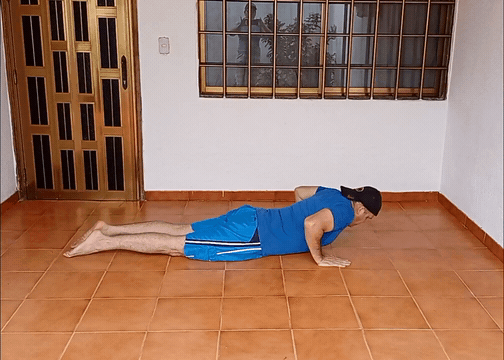
**
Cobra push-ups
We lie on our stomachs with elbows bent, and hands placed on the sides of the shoulders. Legs together. Now we breathe in, extend the elbows, and raise the torso, exhale, lower, and repeat the exercise for 3 minutes.
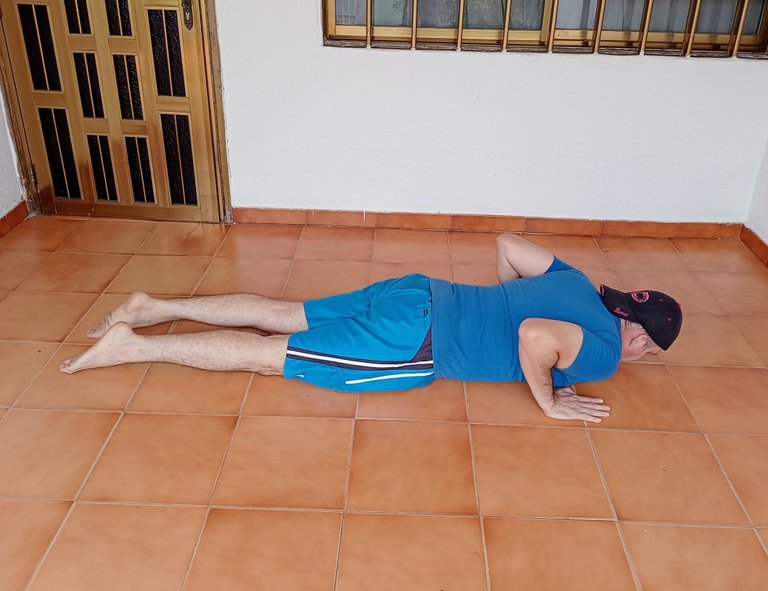
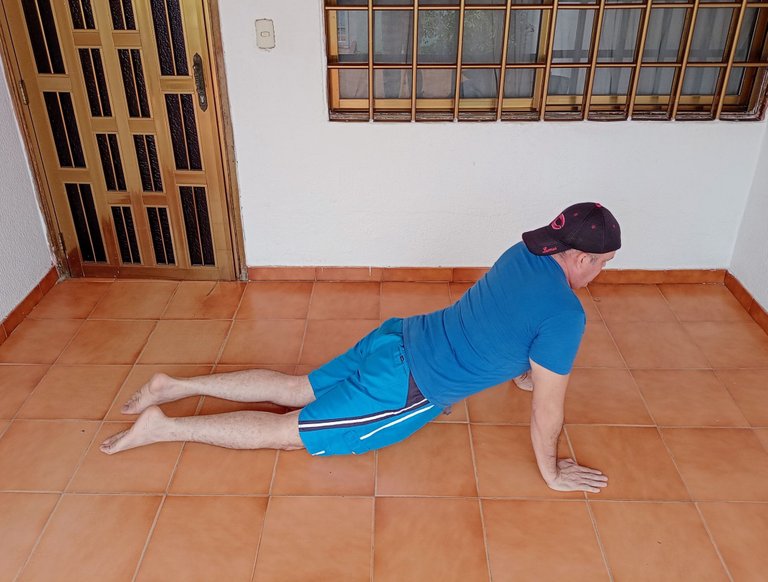

De verdad que me siento complacido y contento, por la satisfactoria ejecución de esta rutina. Espero que les haya servido de mucho esta información, porque realmente cumple con su cometido, desarrollar y fortalecer las zonas del pecho o pectorales. Un abrazo a todos y nos vemos en otra oportunidad, siempre motivados y llenos de energía. Saludos.
I am really pleased and happy for the satisfactory execution of this routine. I hope this information has helped you a lot, because it really fulfills its purpose, to develop and strengthen the chest or pectoral areas. A hug to all and see you all again, always motivated and full of energy. Greetings.
...Gracias Por Visitar...
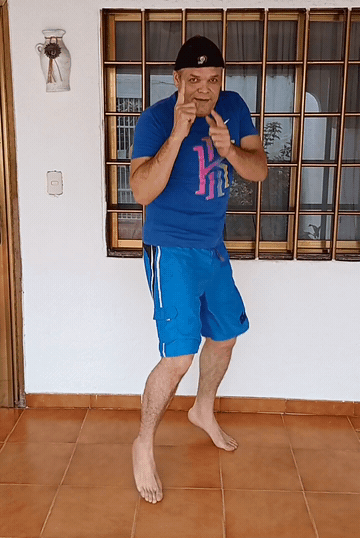
...Thanks for visiting...



Imágenes Fotográficas, tomadas por mi amor Suhaill Núñez.
Photographic images, taken by my love Suhaill Nuñez.
Sorry. English is not our native language. Therefore, a web translator is used for texts in English. (Spanishdict)
https://twitter.com/OmarRojas1974/status/1534852125574012928
The rewards earned on this comment will go directly to the people sharing the post on Twitter as long as they are registered with @poshtoken. Sign up at https://hiveposh.com.
SUPER EXPLICACION ME ENCANTO SUS EJERCICIOS
Gracias hermano, esa es la idea que se entienda todo como debe ser. Un abrazo.
Y hoy tocó una rutina full intensa para el pecho y brazos, muy buena tu rutina hermano me gustó mucho, sabes que uno de mis ejercicios favoritos son las flexiones así que diste justo en el clavo, imagino quedaste reventado luego de ésta rutina, saludos!
Como no hermano, quedamos exhaustos, pero felices. Con esta posición de manos, las flexiones se hacían cada vez más intensas. Saludos.
Mi hermano, siempre trayendo buenas informacion para estar en forma, son ejercicions muy necesarios. Un abrazo y mil bendiciones.